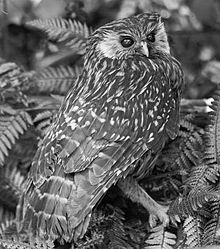Wikijunior:Extinct Birds/Laughing Owl

The Laughing Owl, whēkau or white faced owl, is an owl that hails from New Zealand. The last Laughing Owl was reported dead on a street in Blue Cliffs Station, near Timaru in New Zealand (in 1914).
Extinction
[edit | edit source]The reason why this owl went extinct, in 1914, was because it had no defense against their predators, who were wild mammals (like the effective hunters of beetles, birds, and lizards). Even humans hunted the owl for museums and zoos. Land changes might have played a role as well in the extinction of these birds. Trees were destroyed for the benefit of humans (such as homes). Subsequently, they had nowhere to live.
Characteristics
[edit | edit source]The overall length of a Laughing Owl was 35.5–40 cm, male laughing owls are usually taller than female laughing owls.
Habitat
[edit | edit source]The Laughing Owl was mostly/only found in New Zealand, living in tree holes. They're preserved nests from trees, in which the nests were former shelters for Laughing Owls. Another habitat for the Laughing Owl Species is rocky areas. If the Laughing Owl was still here today, they'd probably live in Southern Alps, Canterbury, or Otago. These species prefer the wide country habitats than the forest, they prefer it for their shelter and food. They also lived in caves, rock ledges, and rock faces.
Food
[edit | edit source]
Before the arrival of humans, the Laughing Owl preyed on native species such as Kiwi and Duck. The laughing owl preyed on lizards, insects, birds, mice, and rats. The Laughing Owl also preyed on larger birds, such as the Weka, and even the Morepork, the other New Zealand owl. Following the Polynesian Arrival, the change of the environment, resulting in the decrease of food for the Laughing Owl, the Pacific Rat became important for the Laughing Owl's Diet.
